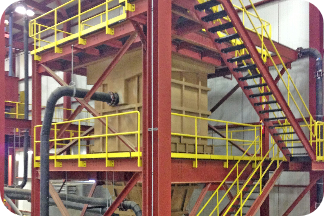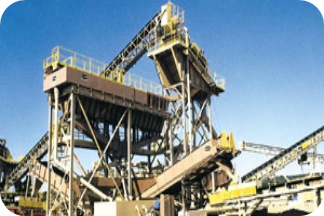



CFS DENSITY SEPARATOR
The Density Separator is the next generation of hydraulic classification. (Principles of Operation included.) The Density Separator starts with an extremely efficient classification tank and implements a process controller to maintain the equilibrium of the machine.
The accuracy of classification is extremely good. The overflow receives the fine fraction and the underflow the coarse fraction. This is 90% – 95% efficiency. This can be changed by easily adjusting the controller setting. Since sand classification is based on a cumulative percentage, it works very well for a Density Separator to make one cut (ie., 30,40, or 50 mesh cut point) By means of blending back the maximum of each fraction, you obtain the highest available yields possible. As the feed analysis changes, the customer has extremely tight control of FM by the automatic change of process controller or by adjusting the blend back gate.
Although the Density Separator is more upright, this allows for overflow to be cycloned by gravity. With the underflow of Density Separator being approximately 75%, and the overflow cycloned the % solids of these fraction is 65% – 68% solids. Thereby reducing the dewater equipment required and making it more efficient.
Specialty sand is not a problem for the Density Separator. Approximately 90% of industrial sand producers are using a Density Separator rather than a Y-Box type. foundry, golf course, fiberglass, filter, and frac sand are all being made with the CFS Unit Most specialty sands require sharp cuts such as 30 x 140 mesh, 20 x 40, or 30 x 50 mesh. Changes in AFS can be easily made by a change in the process controller setting.
The key area that the Density Separator exceeds the competitive sand tanks is in the amount of yield. The Density Separator is unmatched at saving the material which the customer is short. This also directly impacts the amount of waste.
TYPICAL CLASSIFICATION TANK
Classification tanks are widely used in sand and gravel plants throughout North America. Many have been successful and do a very good job of classifying sand. As a customer gets into lower yield sand or closer tolerance specification, sand classification becomes more difficult with a sand tank.
The classification tank is the traditional method of classifying sand. This is a very old technology. The tank has many moving parts. A typical classifying tank has eleven stations and thirty-three valves.
Tank is an inherently poor classification tool, which has adapted very sophisticated and complicated controls, in order to improve the classification. Most of these are timers or sensors which do nothing for sand classification.
The tank makes specification by dumping stations. Each station may contain needed product. Dumped station to go to second product or to waste.
Sand tank will make spec when sand does not range too widely, perhaps from FM 2.50 – 2.90. (Assuming a FM, 2.70 product spec.) The wider the difference the more the yield is reduced and the larger the waste.
Sand tanks are probably unable to make specialty sands such as filter, golf course, foundry, frac and fiberglass.
The sand tank cycles and discharges at widely different % solids. (50% average)